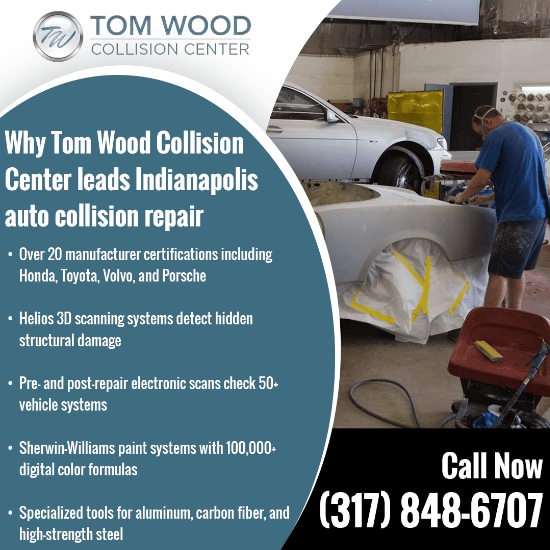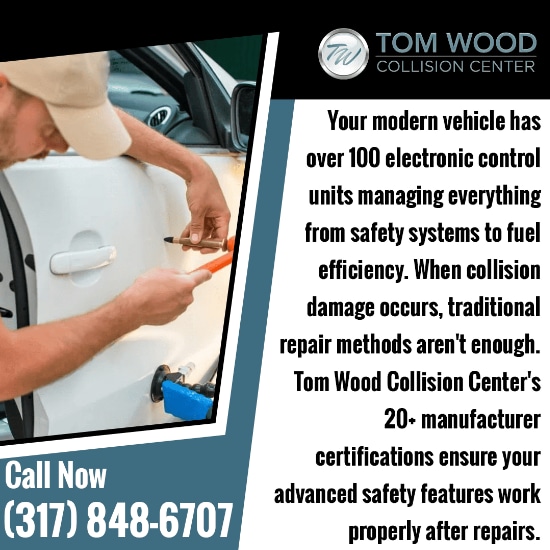Today's cars are completely different from vehicles made even five years ago. They contain sophisticated computers, multiple cameras, radar sensors, and lightweight materials that require specialized knowledge to repair properly. The collision repair industry has evolved to keep pace with automotive technology. What worked for repairing cars in the past simply won't work for today's vehicles.
Modern collision repair near you must address both visible damage and the complex electronic systems that keep you safe on the road. At Tom Wood Collision Center, we understand these challenges and have invested in the advanced equipment, manufacturer certifications, and specialized training needed to repair modern vehicles correctly. Since 2012, we've served Indianapolis area drivers by staying ahead of automotive technology changes and maintaining the highest repair standards.

Modern Vehicles and Their Complexity
Modern vehicles contain more computers, sensors, and advanced materials than ever before, making them fundamentally different from older cars. A typical new vehicle contains over 100 electronic control units (ECU) that manage everything from engine performance to safety systems. Some luxury and advanced vehicles can have up to 150 ECUs. These computers constantly communicate with each other through networks that process thousands of messages per second.
Your car's electronic systems work together like a team. The engine computer monitors fuel efficiency while the transmission computer adjusts shift patterns. Meanwhile, safety computers watch for potential crashes and prepare protective systems. When collision damage disrupts this network, multiple systems can malfunction.
Smart Safety Features Transform Vehicle Design
Automatic emergency braking uses front-mounted cameras and radar to detect obstacles ahead. Lane departure warnings rely on cameras that read road markings. Blind spot monitoring uses radar sensors in your rear bumpers to track approaching vehicles.
These safety features have become standard equipment rather than luxury options. According to the National Highway Traffic Safety Administration, automatic emergency braking (AEB) systems, including pedestrian detection, will be required as standard equipment on all new passenger cars and light trucks by September 2029. This widespread adoption means most auto collision repairs now involve safety system components.
Crash data recording systems store information about accidents in your vehicle's computers. This data helps technicians understand what forces your car experienced and which systems need inspection or replacement.
Advanced Materials Change Repair Approaches
Car manufacturers now use advanced materials that require specialized repair approaches:
-
Ultra-high-strength steel - Provides superior crash protection while weighing less than traditional steel
-
Aluminum body panels - Reduce vehicle weight for better fuel economy and performance
-
Carbon fiber components - Offers maximum strength with minimum weight for luxury and sports vehicles
These materials require completely different tools and techniques. Welding aluminum needs specialized equipment that prevents contamination from steel particles. Carbon fiber components often need complete replacement because repairs may not restore full strength. Mixed-material construction also presents unique challenges.
Why Repair Techniques Vary for Modern Cars
Each vehicle manufacturer uses unique engineering approaches, materials, and safety systems that make one-size-fits-all repair methods obsolete. The days of universal repair techniques are over. What works for a Honda won't work for a BMW, and electric vehicle repairs differ completely from traditional gas-powered cars. This variation creates significant challenges for collision repair shops.
Modern vehicles also face much stricter safety standards. Insurance companies and regulatory agencies now require repairs to restore the exact factory crash protection ratings. This means repair shops can't use approximations or shortcuts that were acceptable for older vehicles.
Every Brand Has Different Requirements
Each manufacturer designs vehicles using their own engineering philosophy and construction methods. Tesla uses all-aluminum construction with unique battery integration, while BMW combines steel frames with aluminum panels and carbon fiber accents. Mercedes-Benz employs specific material joining sequences to prevent structural weakness.
Volvo requires exact safety system calibration procedures to maintain crash avoidance ratings. Toyota hybrid systems operate differently from Honda's hybrid technology. These are mandatory requirements for safe, proper repairs.
Using the wrong repair method can void your warranty, compromise your safety, and create legal liability for repair shops. This is why professional collision repair facilities must invest in brand-specific training and certification programs.
Interconnected Systems Create Ripple Effects
When one system is damaged, it can affect multiple other systems throughout your vehicle. Modern cars don't have isolated components anymore. Everything connects to everything else through computer networks that share information constantly.
A damaged front sensor can disable multiple safety features simultaneously, and replacing one component often requires reprogramming several others. Warning lights may appear for systems that seem unrelated to the collision damage. Simple repairs can become complex when system dependencies are discovered.
Material Combinations Complicate Repairs
Your modern vehicle likely contains multiple materials that behave differently during repairs. Mixed construction means one car might have steel, aluminum, and carbon fiber parts all in the same vehicle. Heat sensitivity varies between materials during welding processes.
Expansion rates differ when materials are heated, causing warping if not controlled properly. Compatibility issues arise when different materials must be joined together. These material challenges explain why repair shops need specialized equipment, training, and procedures for each type of vehicle they service.
Essential Modern Collision Repair Techniques
Professional collision repair now requires specific methods to properly restore today's complex vehicles to factory standards. Modern auto collision repair involves several key processes that didn't exist for older vehicles. Each technique addresses challenges created by advanced electronics, lightweight materials, and integrated safety systems.
Advanced Electronic Diagnostics
Complete electronic scanning identifies all damaged systems before repairs begin and verifies proper function after completion. These diagnostic procedures test every electronic system in your vehicle using specialized computer equipment. This process reveals hidden problems that visual inspection cannot detect and prevents issues that could appear weeks or months after repairs. Professional collision repair near you should include both pre-repair scanning and post-repair verification to confirm all systems work properly.
Precision ADAS Calibration Procedures
ADAS calibration requires positioning accuracy within millimeters to work correctly. The process uses special targets and metal reflectors positioned at exact distances from your vehicle. Camera alignment must be perfect because even small positioning errors can cause your safety systems to malfunction.
Some calibrations also require controlled road testing to verify that systems work correctly while driving. This dynamic testing confirms that safety features operate properly under real-world conditions.
Specialized Material Joining Methods
Modern materials require advanced joining techniques that go beyond traditional welding. High-strength steel uses computer-controlled welding systems, while aluminum welding requires completely different approaches to prevent oxidation and burn-through. Structural adhesives now supplement welding in many modern vehicles. These adhesives must be mixed in exact ratios and applied under controlled conditions to achieve full strength.
Computer-Controlled Paint Application
Modern refinishing systems eliminate variables that affect color and finish quality. Color matching uses computer analysis to create digital formulas that account for metallic effects and color-changing properties.
Automated mixing systems and environmental controls prevent defects and achieve precise color matches. This creates more durable finishes that last longer and look better than manual application methods.
How Tom Wood Collision Center Approaches Modern Auto Collision Repair in Indianapolis
At Tom Wood Collision Center, we combine manufacturer certifications, advanced equipment, and systematic processes to deliver complete modern vehicle restoration. We've invested in the training, equipment, and facility upgrades necessary to repair today's sophisticated vehicles correctly. Every repair follows our structured process designed to address both visible damage and hidden system problems. This systematic approach prevents overlooked issues and delivers reliable, long-lasting results.
Advanced Damage Assessment Protocol
We use Helios by UVEYE AI-powered scanning to create detailed three-dimensional maps of vehicle underbodies. This technology identifies structural damage, suspension problems, and exhaust system issues that visual inspection cannot detect.
Our electronic pre-scanning tests over 50 vehicle systems simultaneously. This comprehensive testing reveals damaged sensors, communication errors, and calibration problems before we begin repairs. We also perform impact analysis using crash data and damage patterns to predict which systems likely need attention.
Manufacturer-Approved Repair Execution
Our 20+ manufacturer certifications provide us access to current repair procedures and technical support for all major vehicle brands. We follow certified repair procedures that specify exact materials, tools, and techniques for each vehicle model. These procedures are updated regularly as manufacturers refine their methods or introduce new technologies. Quality checkpoints throughout our repair process verify compliance with manufacturer specifications.
We maintain digital documentation that records measurements, test results, and procedure compliance for warranty purposes. This attention to detail sets our auto collision repair in Indianapolis apart from shops that use generic repair methods.
Integrated Technology Systems
At Tom Wood Collision Center, we use Sherwin-Williams Collision Core Pronto paint systems that store formulas for over 100,000 vehicle colors. Our automated mixing eliminates human error and provides consistent color reproduction every time. We employ laser frame measurement systems that track structural corrections in real-time. This continuous monitoring prevents over-correction and achieves precise dimensional restoration.

Comprehensive Quality Verification
After completing auto collision repairs, we conduct a final inspection that includes road testing under various driving conditions. Our highway testing verifies electronic stability control and cruise control systems, while city driving tests parking sensors and low-speed maneuvering features.
We perform paint quality evaluation using standardized lighting to check color match, texture, and finish uniformity. Our system functionality verification confirms that all electronic systems communicate properly and operate within specification ranges, preventing intermittent problems that could appear after delivery.
Trust Your Modern Vehicle to the Right Experts
Choose shops with current certifications, advanced equipment, and demonstrated expertise in modern vehicle technologies for collision repair near you. Look for manufacturer certifications that verify repair facilities meet specific training and equipment standards. Equipment investment indicates a shop's commitment to proper repair capabilities, as modern collision repair requires significant investment in diagnostic tools and calibration equipment.
Tom Wood Collision Center's certifications, equipment, and systematic approach provide the foundation for reliable modern vehicle repair. Our investment in technology and training delivers results that meet manufacturer standards and exceed customer expectations.
Contact Tom Wood Collision Center at (317) 848-6707 for your free estimate. We provide manufacturer-approved auto collision repair in Indianapolis and surrounding communities. When your modern vehicle needs professional restoration, trust the experts who understand today's technology and have the right tools to do the job correctly.

